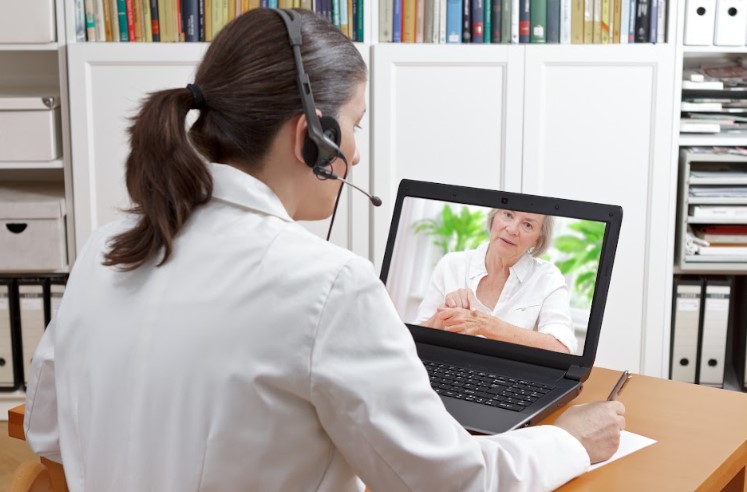
@ShahidNShah

Teledermatology is a rapidly growing field that uses digital technology to diagnose and treat skin conditions remotely. With the rise of the digital age, patients can now receive dermatological care from the comfort of their own homes. This innovative approach to healthcare has revolutionized the way skin care is delivered, providing patients with greater access to medical professionals and improving the overall quality of care.

Teledermatology is a branch of telemedicine that uses telecommunication technology to provide dermatological care remotely. It involves the use of video conferencing, digital imaging, and other telecommunication tools to diagnose and treat skin conditions. Teledermatology is particularly useful for patients in remote or underserved areas who may not have access to dermatologists.
The concept of teledermatology dates back to the 1990s when the first telemedicine programs were launched. Since then, teledermatology has evolved significantly with the advancement of technology. In the early days, teledermatology was limited to store-and-forward technology, which involved sending images of skin conditions to dermatologists for diagnosis. However, with the advent of real-time video conferencing, teledermatology has become more interactive and effective.
Teledermatology is a subset of telemedicine, which is the use of telecommunication technology to provide medical care remotely. Telemedicine has become increasingly popular in recent years, and its benefits are well documented. Telemedicine has been shown to improve access to care, reduce healthcare costs, and improve patient outcomes. Teledermatology is a prime example of how telemedicine can be used to improve access to specialized care, particularly for patients in remote or underserved areas.
Teledermatology is a rapidly growing field that utilizes technology to provide remote skin care services to patients. The success of teledermatology is largely attributed to the technological foundations that enable the transmission of digital images and real-time interaction between healthcare providers and patients. This section will explore the three main technological foundations of teledermatology: Store-and-Forward Technology, Real-Time Interaction, and Smartphone Applications.
Store-and-Forward technology is a method of transmitting digital images and other data from one location to another. In teledermatology, this technology is used to transmit images of skin conditions from patients to dermatologists for diagnosis and treatment. This technology is particularly useful in areas where access to dermatologists is limited. The images can be stored and forwarded to dermatologists who are located in areas with a higher concentration of dermatologists.
Real-time interaction is another technological foundation of teledermatology. It allows dermatologists to interact with patients in real-time, providing immediate feedback and guidance. This technology is particularly useful for patients who require immediate attention or for those who are unable to travel to a dermatologist’s office. Real-time interaction can be conducted through video conferencing, telephone, or other digital communication methods.
Smartphone applications are becoming increasingly popular in teledermatology. These applications allow patients to take pictures of their skin conditions and send them to dermatologists for diagnosis and treatment. The applications also provide patients with information on skin care and prevention. Smartphone applications are particularly useful for patients who live in remote areas or who have difficulty accessing dermatologists.
Teledermatology has emerged as a promising field in the diagnosis and treatment of various skin diseases. It has shown immense potential in improving access to dermatological care, particularly in remote and underserved areas. The following are some of the clinical applications of teledermatology.
Teledermatology enables dermatologists to diagnose and treat skin diseases remotely, using digital images and other telecommunication technologies. It has been found to be particularly effective in the management of acne, psoriasis, and eczema. In addition, teledermatology has also been used to diagnose and treat melanoma and other pigmented lesions, with high levels of accuracy.
To enhance this diagnostic process and support early identification, many teledermatology apps and platforms now offer symptom checkers, visual guides, or interactive quizzes that help patients narrow down possible conditions based on the appearance of their skin. These tools can be particularly helpful in guiding users through common comparisons, like ringworm vs eczema or psoriasis vs seborrheic dermatitis by highlighting key visual and sensory differences. While not a substitute for professional diagnosis, they provide a helpful first step in determining when to seek care.
Teledermatology has been found to be effective in screening for skin cancer, particularly in areas where access to dermatological care is limited. It involves the use of digital images and other telecommunication technologies to screen for suspicious lesions, which can then be further evaluated by a dermatologist.
Pediatric teledermatology has emerged as a promising field, enabling dermatologists to diagnose and treat skin diseases in children remotely. It has been found to be particularly effective in the management of eczema, psoriasis, and acne in children. In addition, teledermatology has also been used to screen for skin cancer in children, with high levels of accuracy.
Teledermatology has been met with some skepticism regarding its accuracy and diagnostic agreement. However, several comparative studies have shown that teledermatology can be just as accurate as in-person consultations.
One study found that teledermatology had a diagnostic accuracy of 91.3%, compared to 92.7% for in-person consultations. Another study found that teledermatology had a diagnostic agreement of 89.1%, compared to 90.8% for in-person consultations. These findings suggest that teledermatology can be a reliable method for skin cancer diagnosis.
Image quality is a crucial factor in the accuracy of teledermatology. High-quality images are necessary to accurately diagnose skin conditions. However, low-quality images can lead to misdiagnosis and inaccurate treatment. Therefore, it is essential to ensure that images are of sufficient quality before making a diagnosis.
While teledermatology can be a reliable method for skin cancer diagnosis, in-person consultations help confirm a diagnosis. In-person consultations at centers like the City dermatology clinic in London allow for a more thorough examination of the skin, which can lead to a more accurate diagnosis. Additionally, in-person consultations allow for the detection of other skin conditions that may not be visible in images.
Teledermatology has been growing rapidly in recent years, and one of the main reasons for this is its accessibility and cost-effectiveness. In this section, we will explore how teledermatology is improving access to dermatological care and how it is analyzing cost-benefit for both patients and healthcare providers.
Teledermatology has made it possible for patients to receive dermatological care from the comfort of their own homes. This is especially important for patients who live in rural or remote areas where access to dermatological care is limited. With teledermatology, patients can receive a diagnosis and treatment plan without having to travel long distances or wait for long periods of time to see a dermatologist in person.
Moreover, teledermatology has also made it possible for patients to receive dermatological care in a timely manner. Patients can upload images of their skin condition to a secure online platform and receive a diagnosis within hours or days. This is a significant improvement over traditional dermatological care, which often involves long wait times for appointments and test results.
Teledermatology is also cost-effective for both patients and healthcare providers. Patients save money on transportation costs and time off work, and they also avoid the cost of unnecessary appointments and tests. Healthcare providers save money on overhead costs, such as rent and utilities, and they also save time by being able to see more patients in a shorter amount of time.
Moreover, teledermatology has been shown to reduce healthcare costs overall. A study by the University of California, Davis found that teledermatology reduced the cost of dermatological care by 50% compared to traditional care. This is because teledermatology reduces the need for in-person appointments and tests, which can be expensive.

Teledermatology has been gaining popularity in recent years due to its convenience and accessibility. Patients can receive dermatological consultations from the comfort of their own homes, eliminating the need for in-person visits. This has led to increased patient satisfaction and improved quality of life for those who have difficulty accessing traditional dermatology services.
Studies have shown that patients who use teledermatology services report high levels of satisfaction with the care they receive. They appreciate the convenience of being able to consult with a dermatologist without having to leave their homes. Additionally, teledermatology has been found to improve patients’ quality of life by reducing the time and cost associated with traditional in-person visits.
Despite the benefits of teledermatology for patients, dermatologists have been slow to adopt this technology. Some dermatologists are concerned about the accuracy of diagnoses made through teledermatology, while others worry about the potential for increased liability.
However, as technology continues to improve and more research is conducted on the effectiveness of teledermatology, dermatologists are becoming more accepting of this practice. In fact, many dermatologists now offer teledermatology services as part of their clinical practice.
Teledermatology involves the transmission of sensitive patient information over the internet. Therefore, privacy and security are major concerns in this field. Health care providers must ensure that patient data is protected from unauthorized access, theft, and misuse. They must also comply with the Health Insurance Portability and Accountability Act (HIPAA) regulations that govern the use and disclosure of protected health information.
To ensure the security of patient data, teledermatology providers use encryption, firewalls, and other security measures to protect against cyber threats. They also obtain informed consent from patients and provide them with detailed information about how their data will be used and protected.
Teledermatology is subject to various legal and regulatory requirements. Health care providers must comply with state and federal laws governing the practice of medicine, including licensure, credentialing, and scope of practice. They must also comply with regulations governing telemedicine, which vary by state.
In addition, health care providers must ensure that they are practicing ethically and within the bounds of professional standards. They must provide high-quality care, maintain patient confidentiality, and avoid conflicts of interest.
As technology continues to advance, so do the possibilities for teledermatology. One area of innovation is in the development of more sophisticated teledermatology systems. These systems will be able to provide more accurate diagnoses and treatment recommendations, as well as offer more advanced imaging and data analysis capabilities.
Another area of innovation is in the integration of artificial intelligence (AI) into teledermatology systems. AI algorithms can be trained to recognize patterns in skin lesions and assist in diagnosis. This technology has the potential to greatly improve the accuracy and efficiency of teledermatology services.
As teledermatology becomes more widespread and accepted, it is likely that it will become integrated into mainstream healthcare. This integration will require changes to the current healthcare system, including changes to reimbursement policies and the development of new clinical services.
One potential benefit of teledermatology integration is increased access to healthcare for patients in rural or underserved areas. Teledermatology can also help to reduce wait times and improve efficiency in healthcare delivery.
However, there are also challenges to integrating teledermatology into mainstream healthcare. One challenge is the feasibility of implementing teledermatology in different healthcare settings. Another challenge is ensuring the quality and safety of teledermatology services.
Teledermatology has emerged as a promising solution for patients seeking skin care in the digital age. With the help of remote consultation, patients can now access specialist care from the comfort of their homes. This has led to improved patient outcomes and reduced healthcare costs.
One of the key benefits of teledermatology is the ability to provide second opinion teleconsulting. Patients can now receive a consultation from a specialist without having to travel long distances. This has not only improved patient outcomes but has also reduced the burden on healthcare resources.
Remote consultation has also enabled patients to receive timely care. Patients no longer have to wait for weeks or months to see a specialist. With remote consultation, patients can receive a consultation within a few days, if not hours.
Overall, teledermatology has revolutionized the field of skin care. It has improved patient outcomes, reduced healthcare costs, and enabled patients to receive timely care. With the continued advancement of technology, it is expected that teledermatology will become even more accessible and effective in the years to come.

The Hospitals in the Home care model is becoming more popular due to rising healthcare costs, workforce shortages and digital health advancesRead on healthcaretransformers.com
Connecting innovation decision makers to authoritative information, institutions, people and insights.
Medigy accurately delivers healthcare and technology information, news and insight from around the world.
Medigy surfaces the world's best crowdsourced health tech offerings with social interactions and peer reviews.
© 2025 Netspective Foundation, Inc. All Rights Reserved.
Built on Jul 1, 2025 at 1:20pm